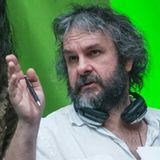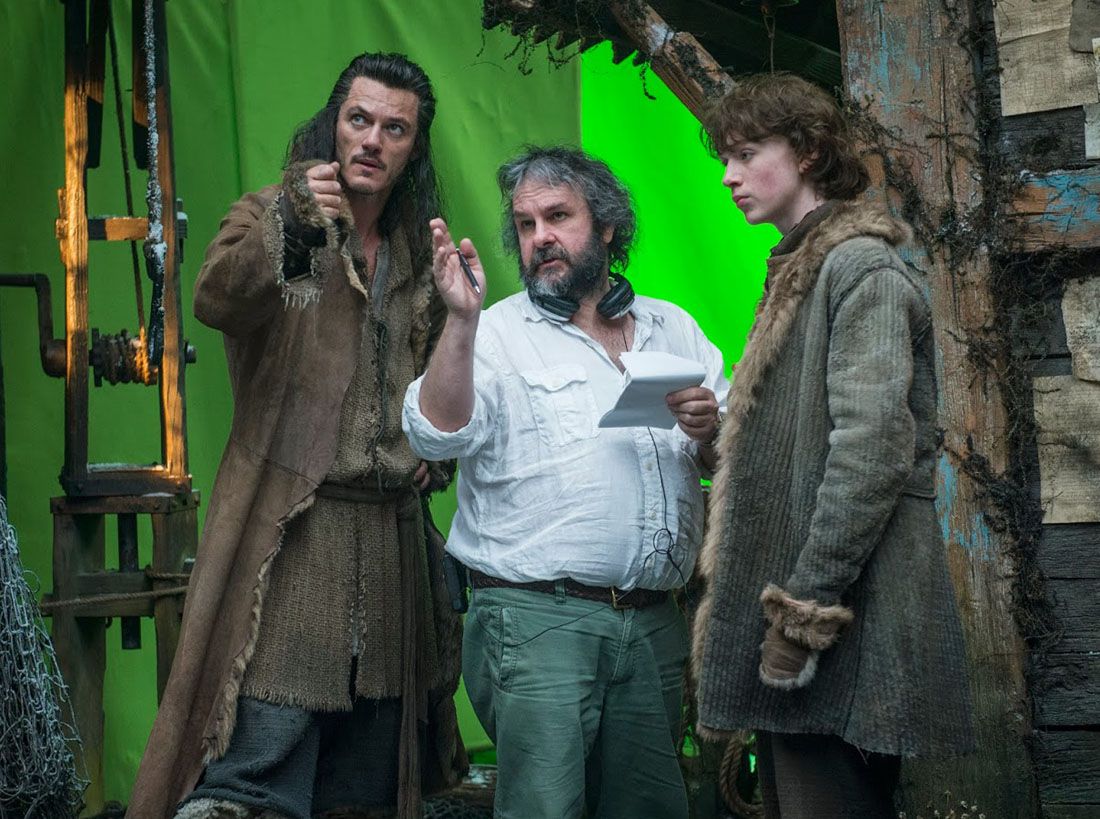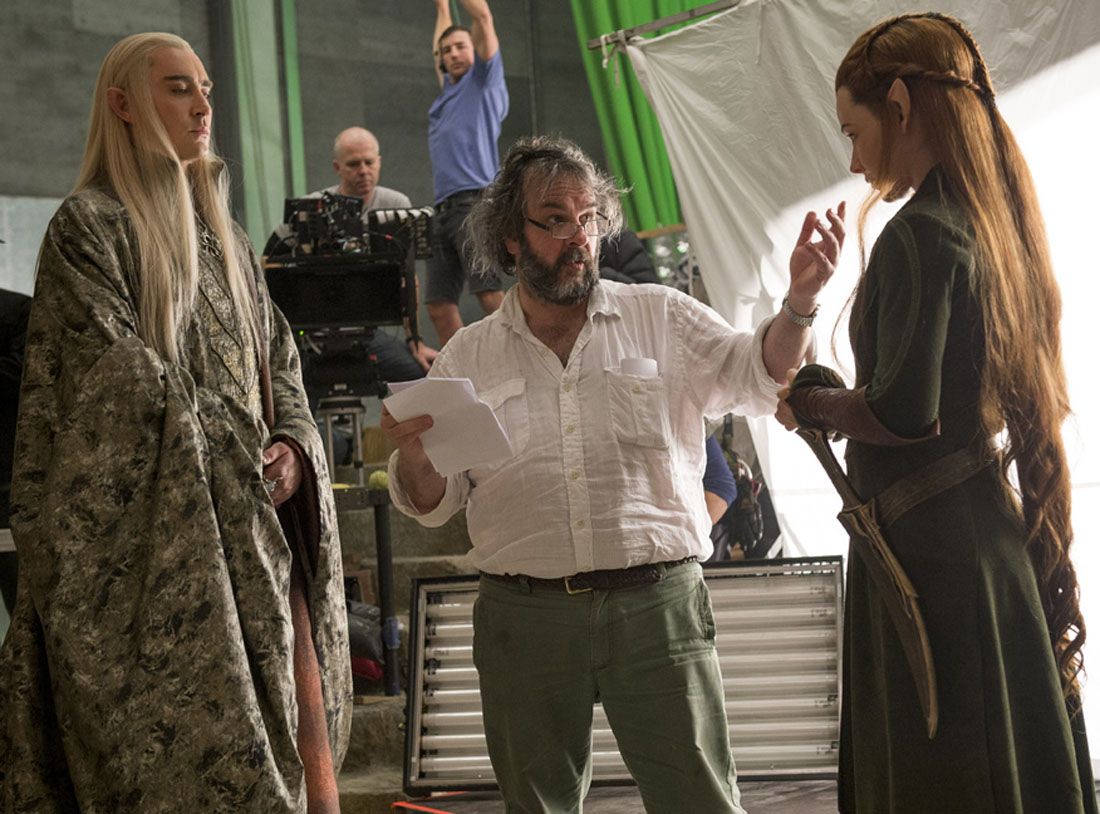Fans were elated when Peter Jackson announced he would be adapt J.R.R. Tolkien’s The Hobbit into two films, completing the saga the director began with The Lord of the Rings. But when he revealed he would expand the series from two parts to three, even diehards questioned the filmmaker's indulgence, particularly given that with Rings, he adapted three novels, and on The Hobbit, he’s dealing with just one.
Jackson seems to allay those doubts with The Desolation of Smaug, which offers a rousing follow-up to An Unexpected Journey and rekindles both the operatic sweep and emotional resonance of The Lord of the Rings.
During a recent press day in Los Angeles for The Desolation of Smaug, Jackson and co-writer/producer Philippa Boyens addressed how the expansion from two to three films affected the structure of the narrative, while the director offered insights into the creation of a new character, Tauriel, and explained some of the specific challenges he faced in bringing this chapter to life.
How did making three movies instead of two affect the structure of each film? Did that allow you to make the second chapter so action-packed? What character benefited the most from that decision?
Peter Jackson: It’s an interesting question. I don’t think any character benefitted from the decision; we didn’t really change a lot. We made that decision after we had shot most of the film. [Behind him, actress Evangeline Lilly points at herself as the chief beneficiary.] It was a decision based on what we had shot, and we just thought, “We’re going to have to somehow cut a lot of this stuff out or we can reshape it.” And we did some more shooting; we did 10 weeks of shooting this year, as well as pickup shooting for the second and third film. What it does, is it allows you to literally let the characters drive the story, because in a novel, the writer of the novel is often the person who narrates the story, who kind of takes you on the journey and Tolkien’s voice is obviously fantastic at doing that. You feel like he’s right beside you telling you a bedtime story.
But in the movie, you don’t want me onscreen telling you what’s happening so the difference in a film is that you have to have the story told through the dialogue of the characters, through their actions. So that’s really why we ended up giving it the sort of depth and explore some of the character depth that we had done Lord of the Rings, because I also was acutely aware that there was going to be, ultimately, when there was going to be this cycle of releasing a movie every year as done, knowing that was six films, I expected Journey to be the beginning and Return of the King to be the end, and I did want to have a unity. I didn’t want to make The Hobbit feel any more simple or any less … I just wanted it to feel like it was the same filmmakers, basically.
Peter, what were the challenges of filming with the special effects?
What I tried to do was, any time we were on a green-screen stage with a lot of bits of sitting, a lot of green screen, I would try to bring in the conceptual art, the artwork that Alan Lee or John Howe or one of the Weta workshop guys had done, so I was able to at least let the guys know what was going to be back on the green screen behind them. Not all the time because sometimes I didn’t even know myself when we were shooting it. Some of those things you figure out later on. But ultimately it’s the power of the imagination. It’s just suspension of disbelief really. Just as the audience, we’re asking you to believe in a world that Elves and Dwarves and dragons and Orcs exist. When you’re on the stage, you have to also be in that same mind frame. You are in that world, no matter whether it’s green or whatever. If there’s a tennis ball that’s supposed to be Smaug, it’s the same thing really.
What are the advantages of working with Martin Freeman as your sort of anchor to this series?
He’s just exploring. He’s exploring the whole time. He’s not saying, “OK, I think that one was perfect, I don’t need to go any more than that.” The next take he’s coming up with a different approach to it, and sometimes a very relatively different approach. Ten years ago, after we wrapped on the Lord of the Rings shoot with Ian Holm, who obviously plays Bilbo as an older man, and Ian McKellen came up to me and said, “Are you OK with what he does?” I said “Why?” and he said – Ian McKellen is a much more of an actor who has a vision for what the scene needs to be about. He’s moving towards that particular goal, and Ian Holm was exploring and experimenting. I said you both have great approaches. You’re the safe and stable one, I know where you’re heading and I’m getting a lot of choice with Martin playing the younger Bilbo, coincidentally is exactly the same style actor as Ian Holm.
How did you decide to create Evangeline’s character, Tauriel, who is not a part of the original book?
In The Hobbit novel, they get captured by the Elves and they escape through the bowels and there’s a memorable part of the book. But, the Elf King isn’t even named. It was only later on that Tolkien decided that he should be Thranduil and he also decided that he had a son when The Lord of the Rings was written, 18 years later. He created the character of the son of the king. So, you have the material there, but you can’t have a scene in a film that’s a memorable scene and not have just one person as the Elf. We wanted three Elven characters who were all different. That’s the thing too is to create characters who have conflict with one another and who have different agendas. I mean, Thranduil, Legolas and Tauriel are all on different flight paths, which makes for more interesting, for Fran and I to write the narratives through their eyes.
One of the things that exists in any large fandom is fan fiction. Is Tauriel maybe a tribute to that?
Philippa Boyens: Women are huge fans of these films – it’s wonderful. Right from Lord of the Rings, there was this immediate engagement with women. You know, there’s this notion it’s a genre for boys, Dungeons & Dragons or something like that, but I’m living proof that’s not true. I always loved these stories, I think they spoke to me, the characters of The Hobbit especially speak to me, Frodo and Bilbo, of course, and when you meet these young women, you do the red carpet and everything and things like that, you understand that passion from the stories that they receive from that is going to create a new generation of writers, young female writers. And I think we’re starting to see that now coming through in the way that fantasy is being used. And one of the things I think women especially enjoy or relate to is that Professor Tolkien attempted to make these stories real, that they feel real, like a history. They read like a history, the sense that this was true. And Pete is I think a genius at sort of making these films feel real even though you have a giant, fire-breathing dragon, that he’s a real character, a real being.
How tough was it to shoot the centerpiece action sequence with the barrels?
Jackson: We had these big V8 water-jet things that we built on a circle – it was like a theme park – about as big as this room. And we were worried because we thought, how fast can we actually grind, wind the engine up, because we could sort of wind it up at speed and, you know, we’d better be careful, you know, because we don’t know quite, it’s gonna be unpredictable and it was. And we had stunt guys doing it, round and round, and testing it and everything else, but you know, these are actors, they’re a little bit fragile (laughter). But by the end of the first day, the guys were just yelling, “Faster! Faster! Get it faster, faster, faster!” And we had it on max, we had the thing going on maximum pretty quickly.
But one of the things that doesn’t really get referenced in the barrels is we also did another shoot on a different river in New Zealand, called the Awatere River in the North Island. And that was a shoot where – that’s a particular river, it’s like a gorge or a canyon, a rocky canyon that stretches about a mile and right at the head of the canyon is a big dam, and four times a day they open up the sluice gates and they just let this enormous torrent of water out, and they let it out for 10 minutes and then they close the gates again. And so we got a lot of the really kind of hair-raising barrel stuff in the Awatere. It would be too dangerous to put a stunt guy down. I mean, we didn’t even dare put anyone in the barrels. We sent the barrels down completely empty and we put the digital Dwarves in later. But that got some of the more dramatic footage, was this – and it was just, it was great because we could set up the cameras when it was dry in between the dumps and we set up about six cameras right the way down the length of the gorge, and then we were there for about three days and every single, you know, four times a day on the dot, these things would open for 10 minutes. And we had a team up, throwing the barrels in, at the top. And we had another guys – you didn’t know what the hell was gonna happen to them, you had just to – they just were filmed on the way down and we had a team at the bottom recovering the barrels. We lost three of them. I mean, to this day, we don’t know where three of those barrels have gone.
So the ending leaves audiences in anticipation, because you have to wait another year. Was that always the moment where you planned to end it, or was it a challenge to decide where you were going to end this film?
We did talk about it and have a discussion about it. It was just a chance that was very rare where you do films back to back, three films back to back. To be able to end on a cliffhanger … I do know where the film ends. And you will see that in a year’s time. I remember when I was 17-19 years old, I remember the big Empire Strikes Back big cliffhanger. It was like three years before the next one came out. We’re being pretty generous with one year. As a Breaking Bad fan, I was hanging a long time for that last half-season or whatever they call it for Breaking Bad.
Given the fact that you are working on three films simultaneously, how do you distinguish each film esthetically? And what changes or adjustments did you make to your approach assembling this film if it all in response to fans from the first film?
There wasn’t really any ability to respond too much because we had already shot everything pretty much, apart from the 10 weeks of pickups we did this year which half of that was the third movie. Five weeks of dramatic stuff. This is a script that was chartered from the beginning and we shot it kind of in chronological order to some degree. So it was actually interesting because by the time we were done with pickups I was just getting in my groove. It was interesting to get completely in to the narrative of the story because as a filmmaker I was getting swept along with the characters day to day. So the filmmaker is on the same journey as the Dwarves to some degree over that period of time. The good thing with the middle film is that you don’t have to set things up, you can just drop into the story assuming that no one is going to see this film that didn’t see the first one. Again, the ultimate life unfortunately as much as the romance of the big screen, the 3D, and everything else is that the ultimate life of these movies is going to be one on Blu-rays, download and hopefully for years to come. That is where they are going to find their ultimate resting place. So you are telling a continuous story. It’s three movies but it is telling one narrative arc and you are trying to make each film work individually. This is the part in the middle where you pick up your foot and put it the gas pedal.
The Hobbit: The Desolation of Smaug opens Friday.



